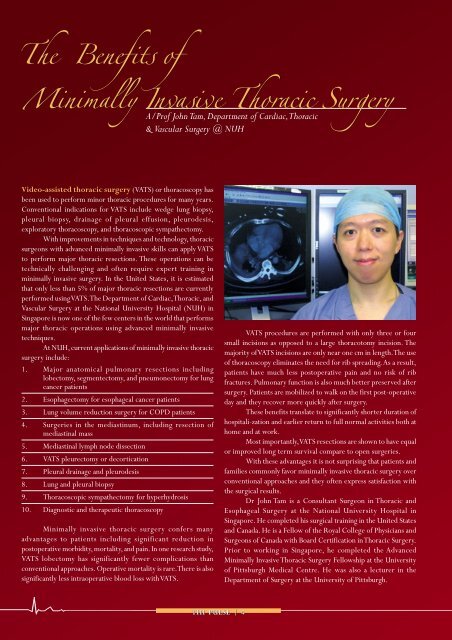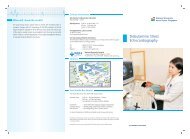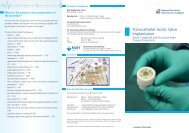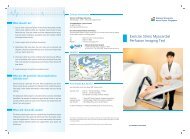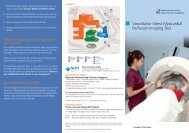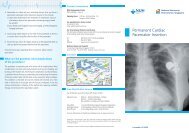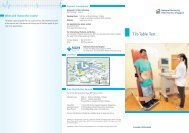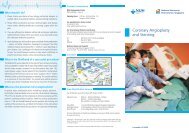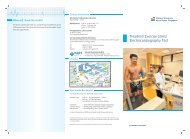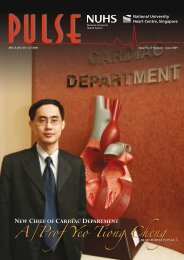Professor Klima and Assistant Professor Kofidis - nuhcs
Professor Klima and Assistant Professor Kofidis - nuhcs
Professor Klima and Assistant Professor Kofidis - nuhcs
- No tags were found...
Create successful ePaper yourself
Turn your PDF publications into a flip-book with our unique Google optimized e-Paper software.
The Benefits ofMinimally Invasive Thoracic SurgeryA/Prof John Tam, Department of Cardiac, Thoracic& Vascular Surgery @ NUHVideo-assisted thoracic surgery (VATS) or thoracoscopy hasbeen used to perform minor thoracic procedures for many years.Conventional indications for VATS include wedge lung biopsy,pleural biopsy, drainage of pleural effusion, pleurodesis,exploratory thoracoscopy, <strong>and</strong> thoracoscopic sympathectomy.With improvements in techniques <strong>and</strong> technology, thoracicsurgeons with advanced minimally invasive skills can apply VATSto perform major thoracic resections. These operations can betechnically challenging <strong>and</strong> often require expert training inminimally invasive surgery. In the United States, it is estimatedthat only less than 5% of major thoracic resections are currentlyperformed using VATS. The Department of Cardiac, Thoracic, <strong>and</strong>Vascular Surgery at the National University Hospital (NUH) inSingapore is now one of the few centers in the world that performsmajor thoracic operations using advanced minimally invasivetechniques.At NUH, current applications of minimally invasive thoracicsurgery include:1. Major anatomical pulmonary resections includinglobectomy, segmentectomy, <strong>and</strong> pneumonectomy for lungcancer patients2. Esophagectomy for esophageal cancer patients3. Lung volume reduction surgery for COPD patients4. Surgeries in the mediastinum, including resection ofmediastinal mass5. Mediastinal lymph node dissection6. VATS pleurectomy or decortication7. Pleural drainage <strong>and</strong> pleurodesis8. Lung <strong>and</strong> pleural biopsy9. Thoracoscopic sympathectomy for hyperhydrosis10. Diagnostic <strong>and</strong> therapeutic thoracoscopyMinimally invasive thoracic surgery confers manyadvantages to patients including significant reduction inpostoperative morbidity, mortality, <strong>and</strong> pain. In one research study,VATS lobectomy has significantly fewer complications thanconventional approaches. Operative mortality is rare. There is alsosignificantly less intraoperative blood loss with VATS.VATS procedures are performed with only three or foursmall incisions as opposed to a large thoracotomy incision. Themajority of VATS incisions are only near one cm in length. The useof thoracoscopy eliminates the need for rib spreading. As a result,patients have much less postoperative pain <strong>and</strong> no risk of ribfractures. Pulmonary function is also much better preserved aftersurgery. Patients are mobilized to walk on the first post-operativeday <strong>and</strong> they recover more quickly after surgery.These benefits translate to significantly shorter duration ofhospitali-zation <strong>and</strong> earlier return to full normal activities both athome <strong>and</strong> at work.Most importantly, VATS resections are shown to have equalor improved long term survival compare to open surgeries.With these advantages it is not surprising that patients <strong>and</strong>families commonly favor minimally invasive thoracic surgery overconventional approaches <strong>and</strong> they often express satisfaction withthe surgical results.Dr John Tam is a Consultant Surgeon in Thoracic <strong>and</strong>Esophageal Surgery at the National University Hospital inSingapore. He completed his surgical training in the United States<strong>and</strong> Canada. He is a Fellow of the Royal College of Physicians <strong>and</strong>Surgeons of Canada with Board Certification in Thoracic Surgery.Prior to working in Singapore, he completed the AdvancedMinimally Invasive Thoracic Surgery Fellowship at the Universityof Pittsburgh Medical Centre. He was also a lecturer in theDepartment of Surgery at the University of Pittsburgh.THI PULSE | 4


